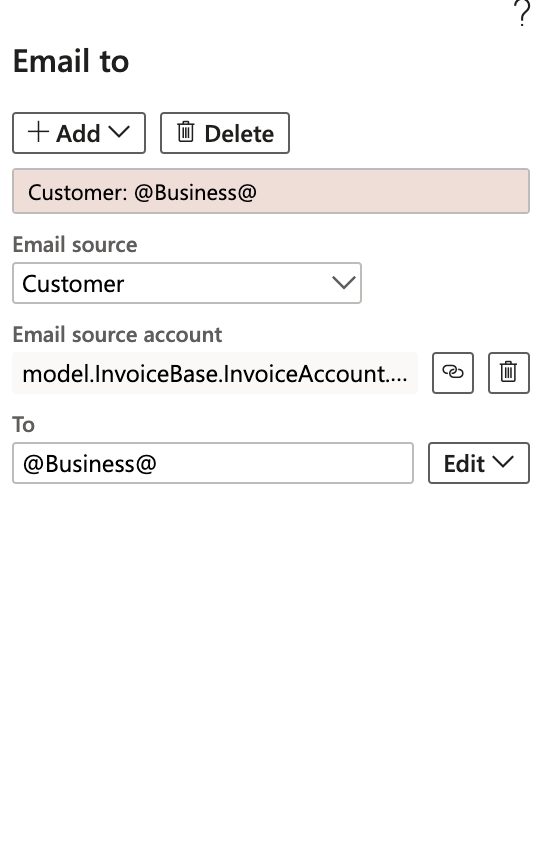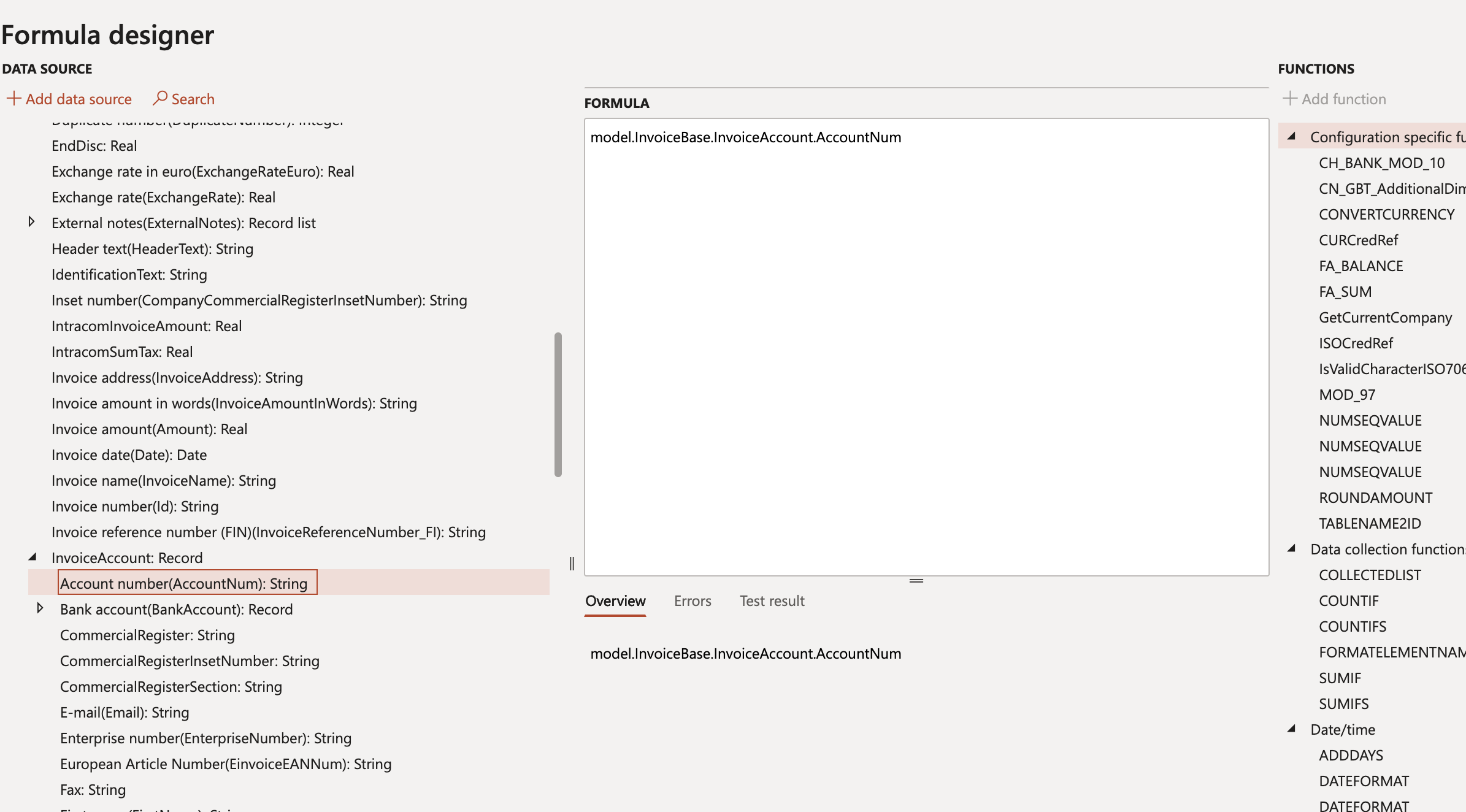Generate report – In this example we are using delivery note report
Copy the below complete code - CustPacking slip email class contains all the code , Report generation, Email template, email place holders mapping, send email using sysoutgoingemailtable and interactive way email
/// <summary>
/// Class to send packing slip email
/// </summary>
public class CustPackingSlipEmail
{
CustPackingSlipJour custPackingSlipJour;
Map mappings = new Map(Types::String,Types::String);
/// <summary>
/// CustPackingSlipEmail
/// </summary>
/// <param name = "_custPackingSlipJour">CustPackingSlipJour</param>
/// <returns>CustPackingSlipEmail</returns>
public static CustPackingSlipEmail construct(CustPackingSlipJour _custPackingSlipJour)
{
CustPackingSlipEmail CustPackingSlipEmail = new CustPackingSlipEmail();
custPackingSlipEmail.parmPackingSlip(_custPackingSlipJour);
return custPackingSlipEmail;
}
/// <summary>
/// CustPackingSlipJour
/// </summary>
/// <param name = "_custPackingSlipJour">CustPackingSlipJour</param>
/// <returns>CustPackingSlipJour</returns>
public CustPackingSlipJour parmPackingSlip(CustPackingSlipJour _custPackingSlipJour = custPackingSlipJour)
{
custPackingSlipJour = _custPackingSlipJour;
return custPackingSlipJour;
}
/// <summary>
/// generateAndSendPackingSlipReport as binary container
/// </summary>
/// <param name = "_args">Args</param>
public void generateAndSendPackingSlipReport(Args _args)
{
//Set variables
Array arrayFiles;
SRSProxy srsProxy;
Map reportParametersMap;
SRSPrintDestinationSettings settings;
Filename fileName = custPackingSlipJour.InternalPackingSlipId + '.pdf';
SrsReportRunController formLetterController = SalesPackingSlipController::construct();
SalesPackingSlipController controller = formLetterController;
SalesPackingSlipContract contract = new SalesPackingSlipContract();
System.Byte[] reportBytes = new System.Byte[0]();
SRSReportRunService srsReportRunService = new SrsReportRunService();
SRSReportExecutionInfo executionInfo = new SRSReportExecutionInfo();
Microsoft.Dynamics.AX.Framework.Reporting.Shared.ReportingService.ParameterValue[] parameterValueArray;
//set the report contract parameters
contract.parmRecordId(custPackingSlipJour.RecId);
contract.parmTableId(tableNum(CustPackingSlipJour));
//2nd paramter contract.parm2ndtParameter('2ndParamter value');
//3rd parameter
//4th parameter
//set the report controller parameters
//set report name and design name
controller.parmArgs(_args);
controller.parmReportName(PrintMgmtDocType::construct(
PrintMgmtDocumentType::SalesOrderPackingSlip).getDefaultReportFormat());
controller.parmShowDialog(false);
controller.parmLoadFromSysLastValue(false);
controller.parmReportContract().parmRdpContract(contract);
// Provide printer settings
settings = controller.parmReportContract().parmPrintSettings();
settings.printMediumType(SRSPrintMediumType::File);
settings.fileName(fileName);
settings.fileFormat(SRSReportFileFormat::PDF);
// Below is a part of code responsible for rendering the report
controller.parmReportContract().parmReportServerConfig(SRSConfiguration::getDefaultServerConfiguration());
controller.parmReportContract().parmReportExecutionInfo(executionInfo);
srsReportRunService.getReportDataContract(controller.parmreportcontract().parmReportName());
srsReportRunService.preRunReport(controller.parmreportcontract());
reportParametersMap = srsReportRunService.createParamMapFromContract(controller.parmReportContract());
parameterValueArray = SrsReportRunUtil::getParameterValueArray(reportParametersMap);
srsProxy = SRSProxy::constructWithConfiguration(controller.parmReportContract().parmReportServerConfig());
// Actual rendering to byte array
reportBytes = srsproxy.renderReportToByteArray(controller.parmreportcontract().parmreportpath(),
parameterValueArray,
settings.fileFormat(),
settings.deviceinfo());
// You can also convert the report Bytes into an xpp BinData object if needed
container binData;
Binary binaryData;
System.IO.MemoryStream mstream = new System.IO.MemoryStream(reportBytes);
binaryData = Binary::constructFromMemoryStream(mstream);
if (binaryData)
{
binData = binaryData.getContainer();
}
SysEmailRecipients recipientEmailAddr = SysUserInfo::find(curUserId()).Email;
//Send email using sysoutgoing email
this.sendEmailWithAttachment(binData, fileName, recipientEmailAddr);
//Send email using interactive methodology
this.sendEmailWithAttachmentInteractive(binData, fileName, recipientEmailAddr);
}
/// <summary>
/// sendEmailWithAttachment using sysoutgoing email table
/// </summary>
/// <param name = "_binData">container</param>
/// <param name = "_fileName">str</param>
/// <param name = "_recipientEmailAddr">SysEmailRecipients</param>
public void sendEmailWithAttachment(container _binData, str _fileName, SysEmailRecipients _recipientEmailAddr)
{
SysEmailItemId nextEmailItemId;
SysEmailTable sysEmailTable;
SysEmailContents sysEmailContents;
SysOutgoingEmailTable outgoingEmailTable;
SysOutgoingEmailData outgoingEmailData;
str subject;
Filename fileExtension = ".pdf";
[sysEmailTable, subject, sysEmailContents] = this.getEmailTemplateDetails();
if (sysEmailTable.RecId > 0)
{
nextEmailItemId = EventInbox::nextEventId();
outgoingEmailTable.clear();
outgoingEmailTable.Origin = sysEmailTable.Description;
outgoingEmailTable.EmailItemId = nextEmailItemId;
outgoingEmailTable.IsSystemEmail = NoYes::Yes;
outgoingEmailTable.Sender = sysEmailTable.SenderAddr;
outgoingEmailTable.SenderName = sysEmailTable.SenderName;
outgoingEmailTable.Recipient = _recipientEmailAddr;
outgoingEmailTable.Subject = subject;
outgoingEmailTable.Priority = eMailPriority::High;
outgoingEmailTable.WithRetries = NoYes::No;
outgoingEmailTable.RetryNum = 0;
outgoingEmailTable.UserId = curUserId();
outgoingEmailTable.Status = SysEmailStatus::Unsent;
outgoingEmailTable.Message = sysEmailContents;
outgoingEmailTable.LatestStatusChangeDateTime = DateTimeUtil::getSystemDateTime();
outgoingEmailTable.TemplateId = sysEmailTable.EmailId;
outgoingEmailTable.insert();
if (conLen(_binData) > 0)
{
outgoingEmailData.clear();
outgoingEmailData.EmailItemId = nextEmailItemId;
outgoingEmailData.DataId = 1;
outgoingEmailData.EmailDataType = SysEmailDataType::Attachment;
outgoingEmailData.Data = _binData;
outgoingEmailData.FileName = _filename;
outgoingEmailData.FileExtension = fileExtension;
outgoingEmailData.insert();
}
}
}
/// <summary>
/// send email as interactive or non interactive methodology
/// </summary>
/// <param name = "_binData">container</param>
/// <param name = "_fileName">str</param>
/// <param name = "_recipientEmailAddr">SysEmailRecipients</param>
public void sendEmailWithAttachmentInteractive(container _binData, str _fileName, SysEmailRecipients
_recipientEmailAddr)
{
System.Byte[] binData1;
System.IO.Stream stream1;
SysEmailTable sysEmailTable;
SysEmailContents sysEmailContents;
str subject;
SysIMailerInteractive mail;
SysMailerMessageBuilder messageBuilder;
Email sendFrom = SysUserInfo::find(curUserId()).Email;
[sysEmailTable, subject, sysEmailContents] = this.getEmailTemplateDetails();
// Turn the Bytes into a stream
for (int i = 0; i < conLen(_binData); i++)
{
binData1 = conPeek(_binData,i+1);
stream1 = new System.IO.MemoryStream(binData1);
}
//email sending settings
mail = SysMailerFactory::getInteractiveMailer();
messageBuilder = new SysMailerMessageBuilder();
messageBuilder.reset()
.setFrom(sendFrom) // From email address
.addTo(_recipientEmailAddr) // To Email address
.setSubject(subject) // Email Subject
.setBody(sysEmailContents); //Email Body
if (stream1 != null)
{
//add attachment to the email
messageBuilder.addAttachment(stream1, _filename);
}
//send email
mail.sendInteractive(messageBuilder.getMessage());
}
/// <summary>
/// getEmailTemplateDetails
/// </summary>
/// <returns>container</returns>
private container getEmailTemplateDetails()
{
SysEmailTable sysEmailTable;
SysEmailMessageTable sysEmailMessageTable;
SysEmailContents sysEmailContents;
str subject;
SysEmailId emailTemplateId = this.getCustPackingSlipTemplateEmailId();
LanguageId language = 'en-Au';
this.populateEmailMessageMap();
select sysEmailTable
join sysEmailMessageTable
where sysEmailMessageTable.EmailId==sysEmailTable.EmailId
&& sysEmailMessageTable.EmailId== emailTemplateId
&& sysEmailMessageTable.LanguageId==language;
subject = SysEmailMessage::stringExpand(sysEmailMessageTable.Subject, mappings);
sysEmailContents = SysEmailMessage::stringExpand(sysEmailMessageTable.Mail, mappings);
return [sysEmailTable, subject, sysEmailContents];
}
/// <summary>
/// Get Email template
/// </summary>
/// <returns>SysEmailId</returns>
private SysEmailId getCustPackingSlipTemplateEmailId()
{
SysEmailId emailId = CustParameters::find().DeliveryNoteEmailId; // new parameter field for email template
if (!emailId)
{
throw error("@Label:DeliveryNoteEmailTemplateError");
}
return emailId;
}
/// <summary>
/// populate map for email place holders
/// </summary>
private void populateEmailMessageMap()
{
SalesTable salesTable = SalesTable::find(custPackingSlipJour.SalesId);
mappings.insert('DeliveryNoteNumber', custPackingSlipJour.PackingSlipId);
mappings.insert('Version', custPackingSlipJour.InternalPackingSlipId);
mappings.insert('SalesOrder', custPackingSlipJour.SalesId ); //strFmt("%1", missingHourTmp.Hour));
mappings.insert('ProjectID', salesTable.ProjId);
mappings.insert('CustAccount', custPackingSlipJour.OrderAccount);
mappings.insert('DeliveryName', custPackingSlipJour.DeliveryName);
mappings.insert('DeliveryAddress', custPackingSlipJour.deliveryAddress());
mappings.insert('InvoiceName', custPackingSlipJour.InvoicingName);
mappings.insert('InvoiceAddress', custPackingSlipJour.invoicingAddress());
}
}
Call the above class from the Sales packing slip controller class extension
[ExtensionOf(classStr(SalesPackingSlipController))]
public final class custSalesPackingSlipController_Extension
{
/// <summary>
/// Send delivery note email
/// </summary>
/// <param name = "_args">Args</param>
protected static void doMainJob(Args _args)
{
boolean sendMail = false;
if (Box::yesNo('@Label:SendDeliveryNoteEmail', DialogButton::Yes,
'@Label:SendDLvNoteEmail') == DialogButton::Yes)
{
sendMail = true;
}
next doMainJob(_args);
if (sendMail)
{
CustPackingSlipJour custPackingSlipJour = _args.record();
CustPackingSlipEmail custPackingSlipEmail = custPackingSlipEmail::construct(custPackingSlipJour);
custPackingSlipEmail.generateAndSendPackingSlipReport(_args);
Info('@Label:DlvNoteEmailSent');
}
}
}




















